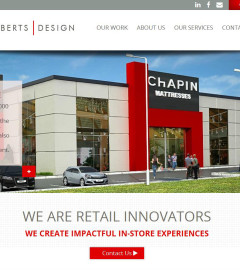
Retail design veteran Martin Roberts reported that he took a brief break from store design projects recently to revamp his own company’s website: http://www.mrobertsdesign.com
“No matter how busy you are, you have to project to your customers that you are in business to do business, and that you are a business they want to do business with,” Roberts says.
Published first in Furniture World Magazine.
“It’s been five years since we began doing business as Martin Roberts Design, and five
years is a long time in terms of web design. If a website is not up-to-date, if it just feels old, you think, ‘I don’t want to work with this
company.’ In our business, we continually tell our clients, ‘You’ve got to keep reinventing yourself in order to stay relevant.’ It was definitely time for us to do the same and to implement a fresh, new look and experience on the web.”
According to Roberts, “In designing a website, the critical thing to keep in mind is what your customers are looking for, and to make sure that you are delivering the things that interest them. In our case, that’s the three ‘F’s’—furniture, fashion and food. We’ve tried to show the variety of things that we do, from home furnishings projects, which are obviously a big part of our business, to strong regional projects like the University of Arkansas Bookstore to the Washington Avenue Highline retail shops.”
The overarching goal, Roberts relates, was to make the site accessible and easy to understand. “The challenge we had is that we have hundreds of case histories and leading-edge projects, but you have to be very short and to the point on the web. Our solution was to create a number of paths so that you can read the site on a number of levels, whether you just dipping in to find something quickly or you want to learn a little bit more about the company, or you want to follow a particular track,” he says. “If you’re a client for fashion or furniture, you can follow each one of those areas and explore case histories and samples and come away thinking, ‘These people know what they are talking about!’ ”
Roberts admits that recreating an existing website is a painful process even for a design firm. “It’s not something you do and forget it,” he says. “Whether you are a retailer, manufacturer or designer, you have to constantly be looking at your site and reevaluating how to make it more interesting and inspiring. This is particularly true for retailers in the furniture industry, where so many of the sites today are produced by a single company and all of the sites look the same. It’s boring, and it’s the most uninteresting and uninspiring way of looking at a category that should be fun and enjoyable.
Think about the way consumers experience furniture on Houzz. They see a room full of furniture and they click on the little green tags and it’s all in context. One of the problems with the catalog sites so many retailers employ is that you don’t know if the product you are looking it is the size of a kennel or as big as a house.”
In addition to case histories, the site offers insight into the company’s services, from consulting to store and showroom design, visual
merchandising and branding. To take the new site for a test drive, visit www.mrobertsdesign.com.